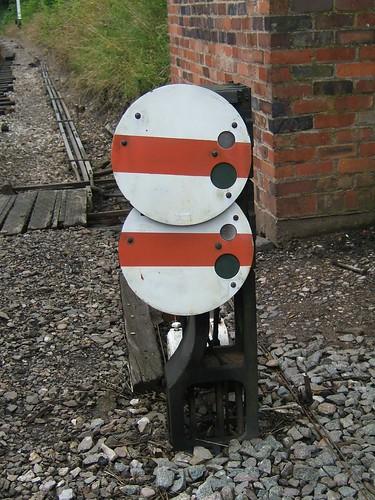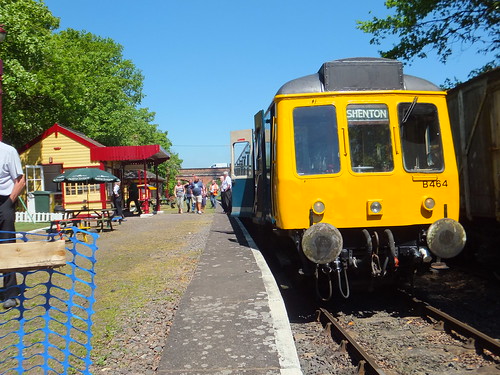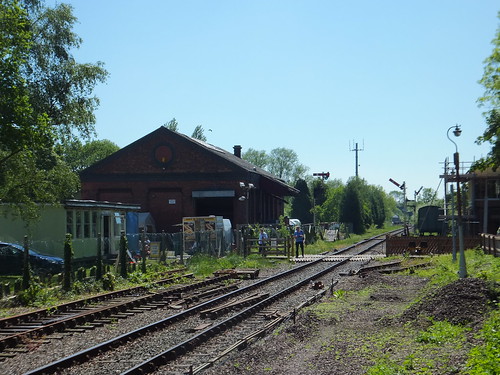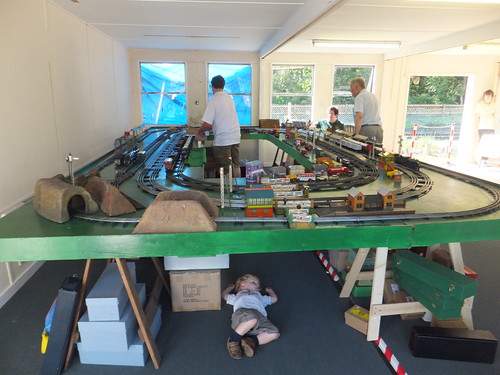'Oliver Cromwell' drifts through the Down Platform at Darley Dale with its 11-coach Charter, passing the empty stock from the 7-coach top-and-tailed service train standing in the Up Platform.
In May 2010, Pete Waterman inaugurated the turntable at Rowsley and I've described this in the post In a Spin with Pete Waterman.
Pete Waterman handsignalling '8F' 8024 onto the 60-foot turntable at Rowsley during the inauguration (Photo: Sheila Rayson).
In July of the following year, Peak Rail's running line was extended from Matlock Riverside to Matlock Town Platform 2. This was the occasion for some festivity, described here.
Peak Rail veteran 68013, carrying headboard and union flags, alongside a completely out-classed '153' DMU at Matlock Town.Normally, Network Rail and Peak Rail operate as separate railways but a Ground Frame allows trains to pass between Network Rail and Peak Rail when required.
The Network Rail Ground Frame at Matlock Town, released by the Key Token for the Ambergate - Matlock line.These two events opened up the possibility of Steam Charter workings coming from Network Rail right through to Rowsley, where the Charter locomotive could be turned and serviced prior to working the Steam Charter back to Network Rail metals. Such a Charter was planned for 2011 but was cancelled. However, on 27th May 2012 a Charter from London via the East Coast Main Line triumphantly terminated at Peak Rail's Rowsley station and returned later in the day. This Charter was in the hands of the popular main-line certified 'Britannia' Class locomotive 70013 'Oliver Cromwell'.
Peak Rail's service train currently operates top-and-tailed with a diesel locomotive at one end and Peak Rail stalwart 'Austerity' tank locomotive 68013 at the other end in between Rowsley and Matlock Town. On the day of the Steam Charter, a special timetable had been arranged, allowing the service train to be 'recessed' when the Steam Charter arrived and departed and I was driver on 68013 with Richard as fireman.
The normal 6-coach rake had been re-inforced to 7-coaches because of likely interest and because it was intended to allow passengers from the Steam Charter to have a round trip on the Peak Rail service as an alternative to a road trip to Chatsworth and Bakewell. In another variation from normal, 68013 was to work at the north end of the train facing north with 'Peak' class diesel electric 'Penyghent' at the south end of the train. Our normal first departure is at 11:15 but on the day of the Steam Charter, the first train was at 09:45. 'Penyghent' hauled the train to Matlock Town and then 68013 returned us to Rowsley.
68013 ready to leave Matlock Town. The 'white feather' from the safety valve indicates that the engine is ready and Richard is taking a breather in the shade alongside the first coach.
With seven coaches and 'Penyghent' on the back, the trailing load on 68013 was well over 400 tons but this presented no problem and my normal setting of not-quite-full 'First Valve' and the reverser taken up two notches allowed us to maintain the timings even though much of the route is uphill at around 1 in 400.
When stopping at Darley Dale, the first two coaches had to be taken beyond the platform to ensure that 'Penyghent' was clear of the Track Circuit extending from the facing points into the platform. Failure to do this would prevent the signalman from reversing the points for an Up train (which would be important later in the day when we would be 'recessed' in the Down Platform for the Up Steam Charter to pass).
On arrival back at Rowsley, we took water from the grey tanker wagon which serves as our water supply. As is often the case with Steam Charters, it appeared that the journey on Network Rail metals was not without incident and we started to get reports of late running. We made our second round trip starting at 11:02 and by the time we got back to Rowsley the delay to the Steam Charter seemed to have extended. Undaunted, we set off again at 12:19 on the third round trip, watering again when we got back to Rowsley.
The special timetable called for our next working to be at 13:29, Empty Stock to Darley Dale where we were to wait on the Up whilst the Steam Charter passed us on the Down on its way to Rowsley. But the late-running Steam Charter was still miles away so instead we were told that there would be a fourth passenger round trip leaving at 13:39 which should allow us to get back to Rowsley around 14:38. On the trip back, when 68013 was doing the work, there were noticeably more photographers around lineside and in the fields. Perhaps it was my imagination, but I seemed to sense their disappointment that we were not the big green engine with a chime whistle that they were expecting. Most of them seemed to make the best of a bad job and took pictures of us anyway.
A fifth passenger round trip had been arranged for us, leaving Rowsley at around 14:50, with only a brief stop in Matlock Town, leaving at 15:17 to be back at Rowsley about 15:39. This trip was performed without incident but on the way back there seemed to be even more people watching. At least nobody was shaking their fist at us or making rude gestures because we were not 'Oliver Cromwell'.
When we got back to Rowsley, we watered again ready for the delayed Empty Stock working. Instead of the originally-planned departure at 13:29, we set off around 15:49 with 'Penyghent' in charge for the short trip to Darley Dale. Here we waited. It wan't too long before we heard a chime whistle and the long-expected train rumbled through and disappeared towards Rowsley.
Photographers and onlookers cluster on the Down Platform at Darley Dale as the delayed Steam Charter approaches.
The arrival was around two hours late, leading to a similarly-delayed departure back to the main line, so the carefully-arranged special timetable had to be abandoned. The original plan was to wait at Darley Dale until 'Oliver Cromwell' had gone on shed and the 11-coach charter train had been shunted into the loop at Rowsley. The Peak Rail service train was then to have returned to Rowsley and provided a round trip to Matlock not stopping at Darley Dale. This working was cancelled and we simply shunted the Peak Rail train across to the Down platform and waited, leaving the Up line free for the returning Steam Charter. We didn't get to see 'Oliver Cromwell' turned, coaled and watered but eventually, around seven o'clock the Steam Charter set off on its return journey.
The Charter return working approaching Darley Dale.
At last, we were able to take our 7-coach train back to Rowsley and shunt 68013 to No. 1 shed road for disposal. 'Penyghent' followed us onto No. 3 shed road. An interesting, if tiring, day.
More pictures here.






